Exhibit.
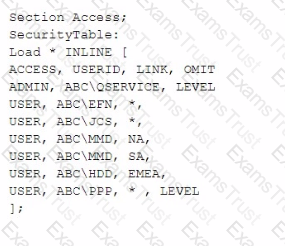
The Section Access security table for an app is shown. User ABC\PPP opens a Qlik Sense app with a table using the field called LEVEL on one of the table columns.
Which is the result?
A data architect needs to load large amounts of data from a database that is continuously updated.
• New records are added, and existing records get updated and deleted.
• Each record has a LastModified field.
• All existing records are exported into a QVD file.
• The data architect wants to load the records into Qlik Sense efficiently.
Which steps should the data architect take to meet these requirements?
A data architect receives an error while running script.
What will happen to the existing data model?
A company generates l GB of ticketing data daily. The data is stored in multiple tables. Business users need to see trends of tickets processed for the past 2 years. Users very rarely access the transaction-level data for a specific date. Only the past 2 years of data must be loaded, which is 720 GB of data.
Which method should a data architect use to meet these requirements?
A company's analytics team is migrating from QlikView to Qlik Sense. During the transition there is an opportunity to improve overall reporting.
Which set of criteria must the data architect consider while planning for the migration?
The data architect has been tasked with building a sales reporting application.
• Part way through the year, the company realigned the sales territories
• Sales reps need to track both their overall performance, and their performance in their current territory
• Regional managers need to track performance for their region based on the date of the sale transaction
• There is a data table from HR that contains the Sales Rep ID, the manager, the region, and the start and end dates for that assignment
• Sales transactions have the salesperson in them, but not the manager or region.
What is the first step the data architect should take to build this data model to accurately reflect performance?
A data architect wants reflect a value of the variable in the script log for tracking purposes. The variable is defined as:

Which statement should be used to track the variable's value?
A)

B)

C)

D)

A data architect executes the following script:

Which values does the OrderDate field contain after executing the script?
Exhibit.
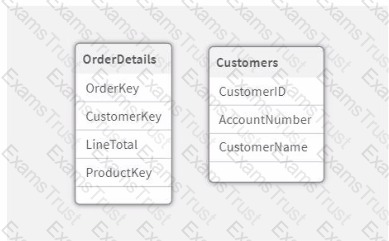
Refer to the exhibit.
A data architect is loading two tables into a data model from a SQL database. These tables are related on key fields CustomerlD and Customer Key.
Which script should the data architect use?
A)

B)

C)

D)
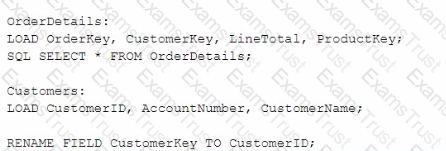
A data architect inherits an app that takes too long to load and overruns the data load window.
The app pulls all records (new and historical) from three large databases. The reload process puts a heavy load on the source database servers. All of the data is required for analysis.
What should the data architect do?
Exhibit.
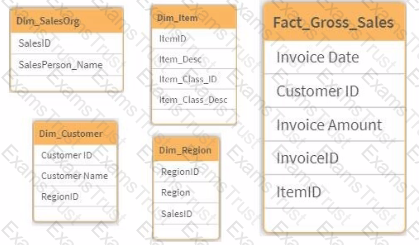
Refer to the exhibit.
A data architect is provided with five tables. One table has Sales Information. The other four tables provide attributes that the end user will group and filter by.
There is only one Sales Person in each Region and only one Region per Customer.
Which data model is the most optimal for use in this situation?
A)
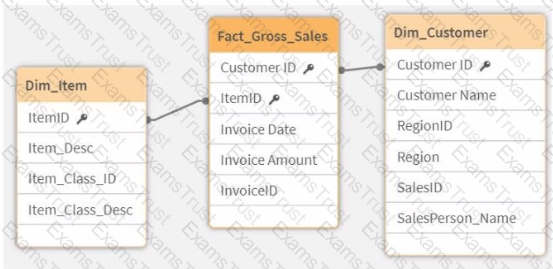
B)

C)
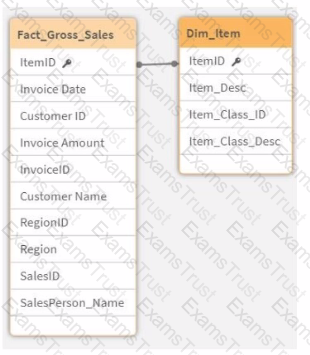
D)
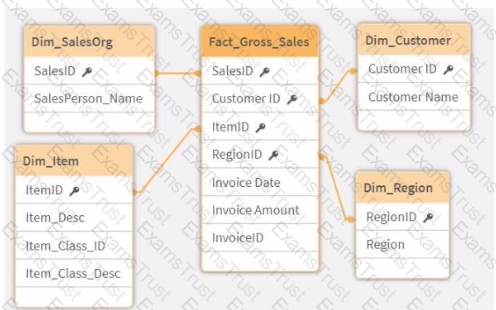
A data architect needs to retrieve data from a REST API. The data architect needs to loop over a series of items that are being read using the REST connection.
What should the data architect do?
A data architect needs to load data from two different databases. Additional data will be added from a folder that contains QVDs, text files, and Excel files.
What is the minimum number of data connections required?

Refer to the exhibit
A large transport company (Company A) acquires a smaller rival (Company B).
Company A has been using Qlik Sense tor 6 years to track revenue per ship journey. Ship journeys with no revenue (such as journeys to shipyards for repair) always show revenue of $0.
Company A wants to combine its data set with the data set of the acquired Company B. Company B's ship journey data shows $0 revenue in one of the following ways:
• A NULL value
• A value with one or more blank spaces (ASCII char code 32)
The data architect wants to conform the Company B data to the Company A standard, specifically regarding the use of an explicit $0 for journeys without revenue. Which script line should the data architect use?
A)

B)

C)

D)


Refer to the exhibit.
A data architect needs to create a data model for a new app. Users must be able to see:
• Total sales for each customer
• Total sales for a given state
• Customers that have not had any sales
• Names of salesperson and regional account managers
• Total number of sales by date
Which steps should the data architect perform to meet these requirements?
Which steps should the data architect perform to meet these requirements?